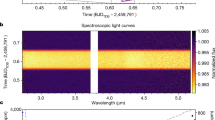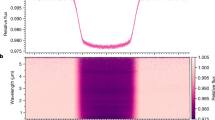Abstract
In contrast to planets with masses similar to that of Jupiter and higher, the bulk compositions of planets in the so-called super-Earth regime (masses 2–10 times that of the Earth) cannot be uniquely determined from a measurement of mass and radius alone. For these planets, there is a degeneracy between the mass and composition of both the interior and a possible atmosphere in theoretical models1,2. The recently discovered transiting super-Earth exoplanet GJ 1214b is one example of this problem3. Three distinct models for the planet that are consistent with its mass and radius have been suggested4. Breaking the degeneracy between these models requires obtaining constraints on the planet's atmospheric composition5,6. Here we report a ground-based measurement of the transmission spectrum of GJ 1214b between wavelengths of 780 and 1,000 nm. The lack of features in this spectrum rules out (at 4.9σ confidence) cloud-free atmospheres composed primarily of hydrogen. If the planet's atmosphere is hydrogen-dominated, then it must contain clouds or hazes that are optically thick at the observed wavelengths at pressures less than 200 mbar. Alternatively, the featureless transmission spectrum is also consistent with the presence of a dense, water vapour atmosphere.
This is a preview of subscription content, access via your institution
Access options
Subscribe to this journal
Receive 51 print issues and online access
$199.00 per year
only $3.90 per issue
Buy this article
- Purchase on Springer Link
- Instant access to full article PDF
Prices may be subject to local taxes which are calculated during checkout


Similar content being viewed by others
References
Adams, E. R., Seager, S. & Elkins-Tanton, L. Ocean planet or thick atmosphere: on the mass-radius relationship for solid exoplanets with massive atmospheres. Astrophys. J. 673, 1160–1164 (2008)
Rogers, L. A. & Seager, S. A framework for quantifying the degeneracies of exoplanet interior compositions. Astrophys. J. 712, 974–991 (2010)
Charbonneau, D. et al. A super-Earth transiting a nearby low-mass star. Nature 462, 891–894 (2009)
Rogers, L. A. & Seager, S. Three possible origins for the gas layer on GJ 1214b. Astrophys. J. 716, 1208–1216 (2010)
Miller-Ricci, E., Seager, S. & Sasselov, D. The atmospheric signatures of super-Earths: how to distinguish between hydrogen-rich and hydrogen-poor atmospheres. Astrophys. J. 690, 1056–1067 (2009)
Miller-Ricci, E. & Fortney, J. J. The nature of the atmosphere of the transiting super-Earth GJ 1214b. Astrophys. J. 716, L74–L79 (2010)
Knutson, H. A., Charbonneau, D., Deming, D. & Richardson, L. J. A. Ground-based search for thermal emission from the exoplanet TrES-1. Publ. Astron. Soc. Pacif. 119, 616–622 (2007)
Mandel, K. & Agol, E. Analytic light curves for planetary transit searches. Astrophys. J. 580, L171–L175 (2002)
Elkins-Tanton, L. T. & Seager, S. Ranges of atmospheric mass and composition of super-Earth exoplanets. Astrophys. J. 685, 1237–1246 (2008)
Nettelmann, N., Fortney, J. J., Kramm, U. & Redmer, R. Thermal evolution and interior models of the transiting super-Earth GJ 1214b. Preprint at 〈http://arXiv.org/abs/1010.0277〉 (2010)
Kuchner, M. J. Volatile-rich Earth-mass planets in the habitable zone. Astrophys. J. 596, L105–L108 (2003)
Léger, A. et al. A new family of planets? “Ocean-planets”. Icarus 169, 499–504 (2004)
Selsis, F. et al. Could we identify hot ocean-planets with CoRoT, Kepler and Doppler velocimetry? Icarus 191, 453–468 (2007)
Lodders, K. & Fegley, B., Jr Chemistry of Low Mass Substellar Objects 1–28 (Springer, 2006)
Léger, A. et al. Transiting exoplanets from the CoRoT space mission. VIII. CoRoT-7b: the first super-Earth with measured radius. Astron. Astrophys. 506, 287–302 (2009)
Queloz, D. et al. The CoRoT-7 planetary system: two orbiting super-Earths. Astron. Astrophys. 506, 303–319 (2009)
Valencia, D., Ikoma, M., Guillot, T. & Nettelmann, N. Composition and fate of short-period super-Earths. The case of CoRoT-7b. Astron. Astrophys. 516, A20 (2010)
Deming, D. et al. Discovery and characterization of transiting super Earths using an all-sky transit survey and follow-up by the James Webb Space Telescope. Publ. Astron. Soc. Pacif. 121, 952–967 (2009)
Kaltenegger, L. & Traub, W. A. Transits of Earth-like planets. Astrophys. J. 698, 519–527 (2009)
Nutzman, P. & Charbonneau, D. Design considerations for a ground-based transit search for habitable planets orbiting M dwarfs. Publ. Astron. Soc. Pacif. 120, 317–327 (2008)
Bean, J. L. et al. The CRIRES search for planets around the lowest-mass stars. I. High-precision near-infrared radial velocities with an ammonia gas cell. Astrophys. J. 713, 410–422 (2010)
Hauschildt, P. H., Allard, F., Ferguson, J., Baron, E. & Alexander, D. R. The NEXTGEN model atmosphere grid. II. Spherically symmetric model atmospheres for giant stars with effective temperatures between 3000 and 6800 K. Astrophys. J. 525, 871–880 (1999)
Acknowledgements
We thank D. Charbonneau, J.-M. Desert, J. Fortney, S. Seager, L. Rogers and D. Sasselov for discussions about this work. J.L.B. received funding from the European Commissions Seventh Framework Program as a Marie Curie International Incoming Fellow. J.L.B. and E.M.-R.K. acknowledge funding from NASA through the Sagan Fellowship Program. The results presented are based on observations made with ESO telescopes at the Paranal Observatories under programs 284.C-5042 and 285.C-5019.
Author information
Authors and Affiliations
Contributions
J.L.B. performed the observations and data analysis, and led the overall direction of the project. E.M.-R.K. calculated theoretical models for the planetary atmosphere. D.H. calculated the stellar limb darkening. J.L.B. and E.M.-R.K. wrote the telescope time proposals and the paper. All authors discussed the results and commented on the manuscript.
Corresponding author
Ethics declarations
Competing interests
The authors declare no competing financial interests.
Additional information
The data utilized in this work can be accessed at the ESO/ST-ECF science archive (http://archive.eso.org/cms/).
Supplementary information
Supplementary Information
This file contains Supplementary Methods comprising Observations, Data reductions and spectral extraction and Photometric corrections, Supplementary Figures 1-2 with legends and an additional reference. (PDF 383 kb)
PowerPoint slides
Rights and permissions
About this article
Cite this article
Bean, J., Kempton, ER. & Homeier, D. A ground-based transmission spectrum of the super-Earth exoplanet GJ 1214b. Nature 468, 669–672 (2010). https://doi.org/10.1038/nature09596
Received:
Accepted:
Published:
Issue Date:
DOI: https://doi.org/10.1038/nature09596
This article is cited by
-
A reflective, metal-rich atmosphere for GJ 1214b from its JWST phase curve
Nature (2023)
-
From Disks to Planets: The Making of Planets and Their Early Atmospheres. An Introduction
Space Science Reviews (2018)
-
A chemical survey of exoplanets with ARIEL
Experimental Astronomy (2018)
Comments
By submitting a comment you agree to abide by our Terms and Community Guidelines. If you find something abusive or that does not comply with our terms or guidelines please flag it as inappropriate.



